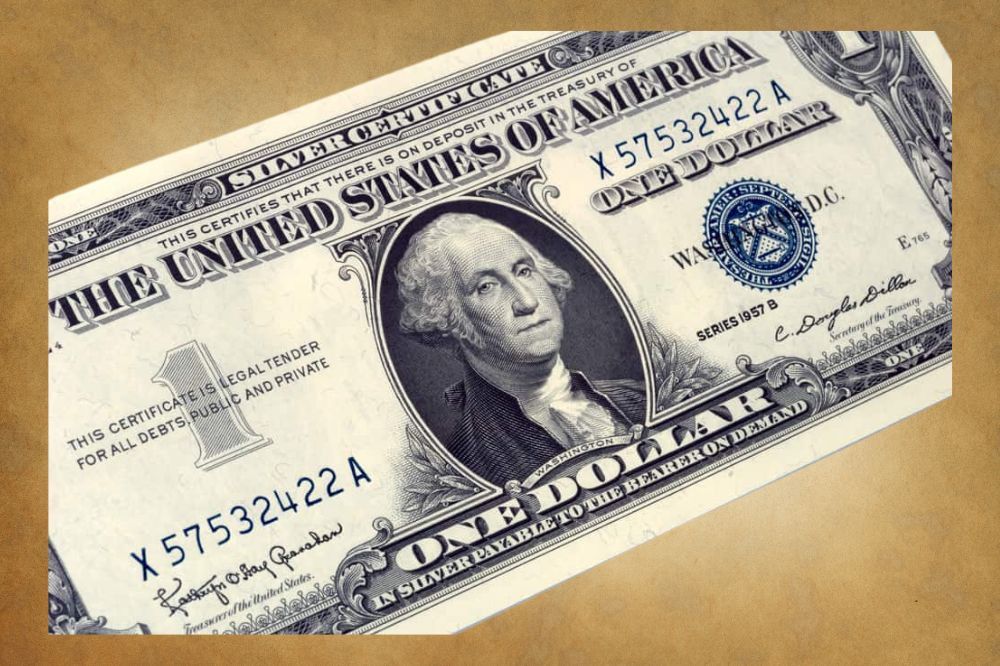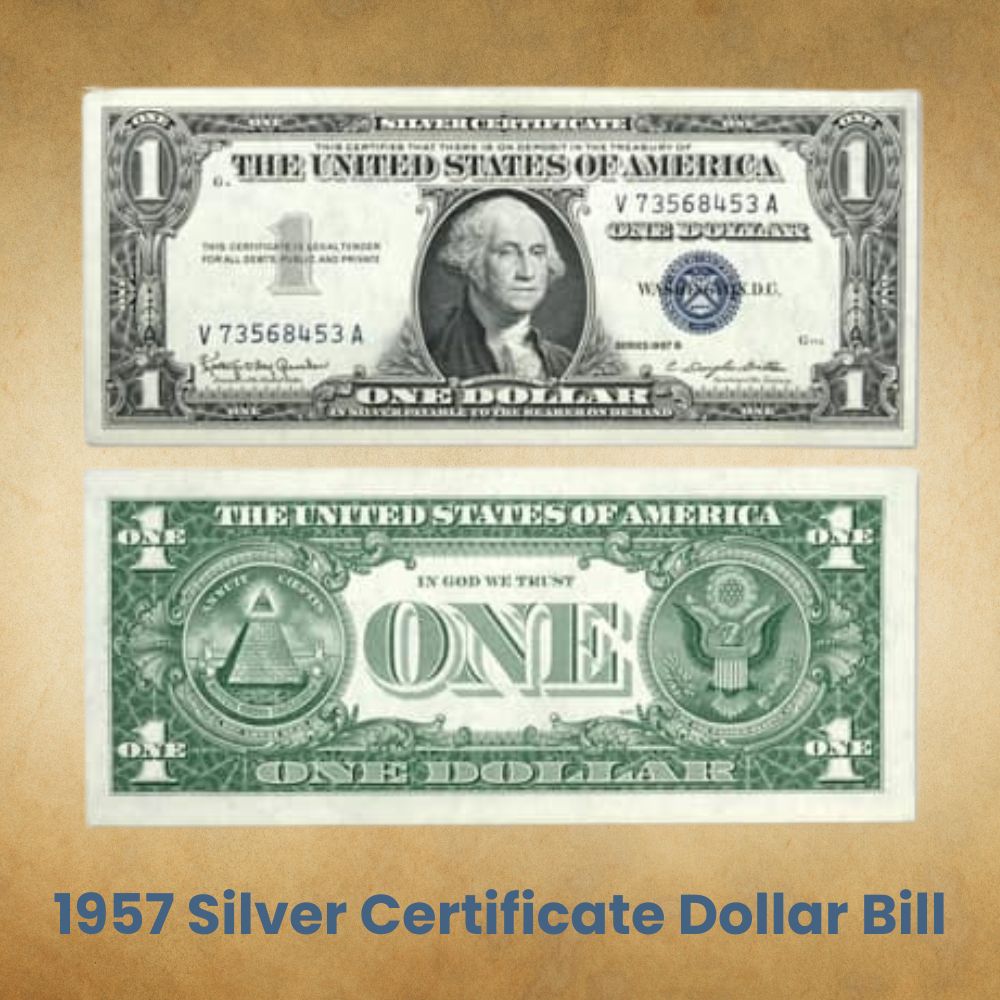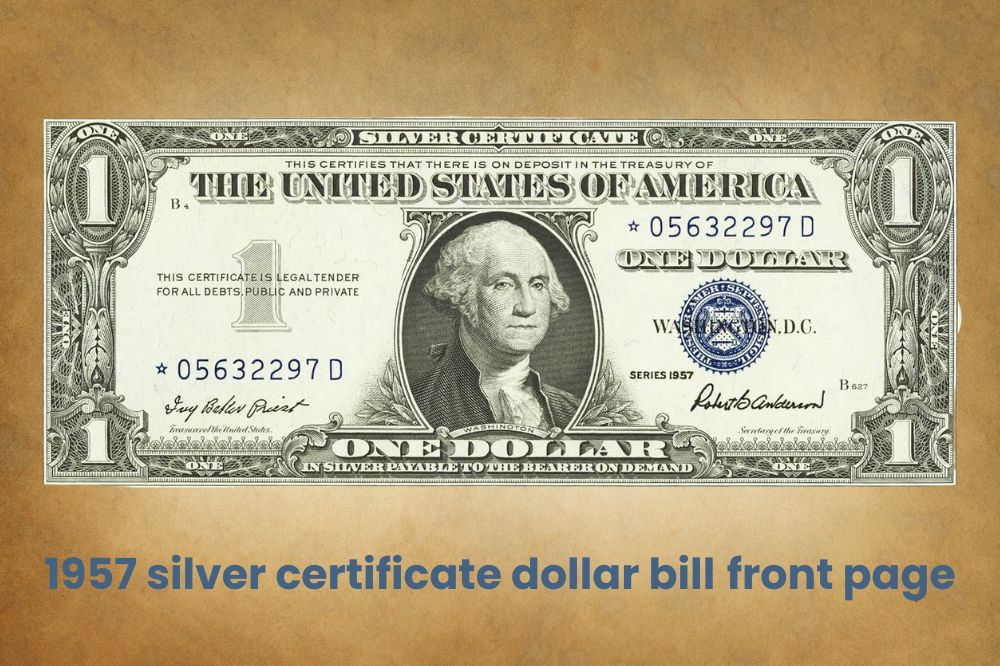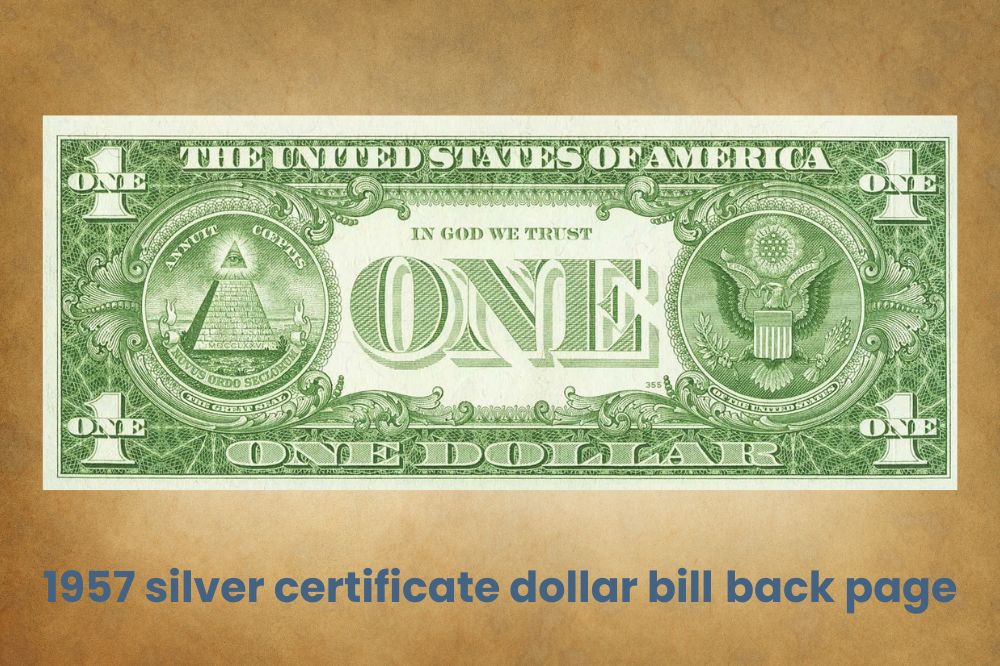1957 Silver Certificate Dollar Bill Value: How Much Is It Worth?

The Bureau of Engraving and Printing produced 5.3 billion $1 bills in 1957. Thanks to such high mintage, the 1957 silver certificate dollar bill value is often only a bit higher than its face value nowadays.
These banknotes with a blue seal were significant as the first American paper money with the motto IN GOD WE TRUST on the back page. Plus, they came in a small-size format, like $1 bills printed in 1928, 1934, and 1935.
1957 Small-size silver certificate dollar bill value |
|||
| Series | Bills in uncirculated condition | Bills in circulated condition | Bills with a star (★) |
| *by PCGS | |||
| 1957 with a blue seal | $18 | up to $5 | $12 to $20 |
| 1957 A with a blue seal | $12 | up to $5 | $10 to $21 |
| 1957 B with a blue seal | $10 | up to $5 | $10 to $24 |
| *by silverrecyclers | |||
| 1957 with a blue seal | $12 to $12.50 | $3.75 | $4.50 to $17.50 |
| *by oldmoneyprices | |||
| 1957 with a blue seal | $3 to $6 | $1,20 to $2 | $10 |
1957 Silver Certificate Dollar Bill Value Guides

Most collectors consider 1957 silver certificate dollar bills the most commonly printed, and their price depends on the condition. Remember that the type may or may not affect their value. You should also check for the following:
- Errors or varieties
- Existing stars
- The serial number arrangement
1957 silver certificate dollar bill
The United States government issued the 1957 silver certificate dollar bills with the possibility for Americans to exchange them for silver of the appropriate value. Unfortunately, such an exchange is impossible nowadays, and most of these banknotes are worth only their face value.
Interestingly, there is often no difference between the three types printed, and 1957, 1957 A, and 1957 B bills cost the same. However, some dealers pay more for the 1957 series than the other two.
Typically, you can get $1 to $5 for banknotes in circulated condition since they are the most commonly issued silver certificates. However, uncirculated pieces’ price range is $5 to $15, depending on the dealer. Banknotes with the star are a bit more appreciated and can cost up to $20.
1957 Silver Certificate Dollar Bill Errors
Despite the high printed number, the 1957 silver certificate dollar bill series is without significant errors. Even star notes are abundant and inexpensive, and most serious collectors never consider adding them to their collections.
In rare cases, it is possible to find the 1957 B $1 silver certificate bill with an inconsistency between two serial numbers (mismatched serial numbers) on the same banknote. It is estimated that such a piece is worth about $750.
You can find two mismatched serial number types resulting from:
- Manual error
- Mechanical error
It is possible to distinguish them by the position of the mismatched digit. For instance, you can be sure that the error is manual when an inconsistency exists between one of the first digits.
When one of the last numbers is mismatched, the error is mechanical and occurs when the numbering machine gets stuck.
Noticing slight imperfections, like folding, inking, or cutting, is possible in some cases, but they are typically insignificant and uninteresting for collectors. The only attractions are notes with unique serial numbers, including:
- Number 1 serial
- Low (under 100 or 1,000) or high (above 99999900) serial
- Perfect up (12345678) or down (87654321) ladders
- Birth year serial (for instance, 00001970)
- Solid serial number (for example, 77777777) or seven digits in a row
- Double quad (for instance, 88889999) or super repeater (for example, 45454545)
- Super palindrome/radar (for instance, 54444445) or simple radar like 00088000
- Binary (only 1s and 0s) or binary super-repeater (01010101)
Collectors are often prepared to pay more for such banknotes, depending on their uniqueness.
History of the 1957 Silver Certificate Dollar Bill
Silver certificates were representative money produced from 1878 to 1964 as part of American paper currency circulation. The first pieces were large-size silver certificates printed by 1923 in $10 to $1,000 denominations, while the first $1, $2, and $5 banknotes were authorized in 1886.
After 1923, the US bank reduced all re-designed banknotes’ sizes, including silver certificates regularly produced as $1, $5, and $10 banknotes. Besides the first ones from 1928, they were issued with series dates of 1934, 1935, and 1957.
The $1 silver certificate coins printed in 1957 were the first American paper currency with the motto IN GOD WE TRUST and the last ever produced with a silver standard. Actually, the early Federal Reserve notes from the 1963 A series came into circulation in the mid-1960s, while the old bills discontinued by the 1963 law were still in use.
1957 small-size silver certificate dollar bill series |
|
| Series | Production period |
| 1957 | 9th September 1957 to 3rd March 1961 |
| 1957 A | 27th January 1961 to 7th February 1963 |
| 1957 B | 17th January 1963 to 6th November 1963 |
Therefore, Americans simultaneously used silver certificates with a blue treasury seal and Federal Reserve notes with a green seal for years. However, the difference was that they only could redeemable the first banknotes for silver.
Most of these bills were worn out or destroyed over time, but they are still legal tender. The government has kept destroying pieces that end up in the bank, so finding them in any condition can be challenging.
The curiosity is that President Kennedy’s last executive order on 4th June 1963 was to phase out silver certificates. The reason was the government’s expectation of a silver bullion shortage.
Many people exchanged those banknotes for silver dollars by March 1964 or for raw silver bullion during the following four years. The redemption period finally ended in 1968, when it was possible to get Federal Reserve notes instead of obsolete silver certificates.
The 1957 series was the final printing year with a relatively low number of produced bills, making that number additionally insignificant. Only rare Americans saved some of these banknotes, making them highly collectible nowadays.
how to identify 1957 Silver Certificate Dollar Bill
Any of survived 1957 $1 silver certificates with a blue seal of 5.3 billion printed are highly desirable nowadays among collectors. This number includes:
- Regular-issue banknotes
- Star replacement bills
- Different signature combinations
You can recognize pieces from the 1957, 1957 A, and 1957 B series. As mentioned, those banknotes are unique as the first American $1 bills with the motto IN GOD WE TRUST.
The front page of the 1957 silver certificate dollar bill

The 1957 silver certificate dollar bill contains centrally positioned George Washington’s portrait, as it has been customary since 1869. The difference is in the side he is facing, and bunches of bay laurel leaves surrounding the oval. Each banknote also includes two signatures and the serial number printed on both sides.
You can see the number 1 on the left and the blue seal with overprinted WASHINGTON, DC, on the right side. The name THE UNITED STATES OF AMERICA is written above the portrait, while the bottom is reserved for the denomination ONE DOLLAR and a note that you can exchange the banknote for silver.
The back page of the 1957 silver certificate dollar bill

The ornate one-dollar bill reverse design includes the Great Seal of the United States. The seal featuring a bald eagle is on the right with a heraldic shield with 13 stripes, while the thirteen stars are arranged above it.
The eagle holds a ribbon in its beak with the inscription E PLURIBUS UNUM, thirteen arrows in its left talon, and an olive branch in the right one.
The left side features a barren landscape with an unfinished, 13-step pyramid with the Eye of Providence on the top. The Roman numerals MDCCLXXVI (1776) at the pyramid base represents the year of American independence.
The central banknote reverse is reserved for the denomination ONE, with the American motto IN GOD WE TRUST above. The denomination ONE DOLLAR is added one more time along the bottom banknote rim.
The country name, THE UNITED STATES OF AMERICA, is written on the top edge, below the note SILVER CERTIFICATE.
1957 silver certificate dollar bill |
|
| Face value | $1 |
| Issuing period | 1878 to 1964 |
| Number printed | 5.3 billion |
| Type | Silver certificate |
| Producer | The US Bureau of engraving and printing |
| The front page | The 1st American President, George Washington |
| The back page | The Great Seal of the US with the motto IN GOD WE TRUST |
| Material | 75% cotton and 25% linen |
| Series | Three types (1957, 1957A, 1957B) |
| Bill height | 2.60937 inches (66.28 mm) |
| Bill width | 6.14062 inches (156 mm) |
| Bill thickness | 0.0043 inches (1.0922 mm) |
| Bill weight | 0.03527 ounces (1 g) |
| Seal variety | Blue |
| Shape | Rectangular |
| Security features | Raised printing and security fibers |
Other features of the 1957 silver certificate dollar bill
The Bureau printed this dollar bill type from 1878 to 1964. Your rectangular banknote weighs precisely 0.03527 ounces (1 g). Its dimensions include a width of 6.14062 inches (156 mm) and a height of 2.60937 inches (66.28 mm). Each contains a few typical characteristics, including:
Seals
The 1957 silver certificate dollar bill contains a blue seal on the right with overprinted Washington DC. Banknotes printed in the mid-50s still didn’t have a black Federal Reserve bank seal on the left side, but you can see the number 1 instead.
Serial number
A standard 1957 silver certificate dollar bill has a serial number printed twice on the front page. You can see eight digits between two letters, but sometimes a star replaces one letter. It happens when something goes wrong during printing, and the star is a sign of replacement.
It is necessary because producing two identical banknotes with the same number is illegal. The law is strict, and there is no matter who would do it, counterfeiters or the US Bureau of engraving and printing.
In rare cases, one number can be different in the line because of an altered digit that occurs during the procedure. However, it is pretty rare since the control is strict and thorough.
Signature
Like other American banknotes, $1-dollar bills from the 1957 series have two signatures on the front page. This particular year, those signatures belong to the following:
1957 series
- Treasury Secretary Robert Bernard Anderson
- Treasurer Ivy Baker Priest
1957 A series
- Treasury Secretary Clarence Douglas Dillon
- Treasurer Elizabeth Rudel Smith
1957 B series
- Treasury Secretary Clarence Douglas Dillon
- Treasurer Kathryn Elizabeth Granahan
Printing
The 1957 silver certificate dollar bill comes with standard raised printing. It is an excellent way to distinguish real and fake banknotes since you can recognize the originals thanks to a specific surface. It will be enough to move your finger over those two and feel the difference.
Paper
Like other US notes, the 1957 silver certificate dollar bill is paper money. However, it is not a real paper, as one might think. They are actually made of cotton and linen fibers in a 75: 25 ratio with added security fibers to prevent counterfeiting.
FAQ about the 1957 Silver Certificate Dollar Bill
What makes a 1957 silver certificate dollar bill rare?
Unfortunately, none of the existing 1957 silver certificate dollar bills are rare, and you can even find a silver certificate set with 1957 and 1957 star notes for $25. Interestingly, some of those notes are still in circulation.
Which 1957 silver certificate dollar bill is worth a lot of money?
The 1957 silver certificate dollar bills are abundant on the market, and even pieces in ultimate condition are inexpensive. According to PCGS, the most expensive is the 1957 XF 40 Priest-Anderson $1 Star Note worth $12.
How much is the 1957 silver certificate dollar bill worth?
Most 1957 silver certificate dollar bills cost $1.25 to $1.50, or a bit more than their face values. However, their price depends on the serial number and each banknote condition, so those in higher rates and with low or usual serial numbers can be worth $3 to $12,50.
What is the rarest silver certificate dollar bill?
The rarest and most valuable silver certificate $1 bills are those printed in 1928 (1928 C, 1928 D, and 1928 E series). Well-preserved notes typically cost about $5,000.

Hi I have couple dollar and coin and penny I want to know how to sale
Call me
I have a 1957 G 26033180A silver certificate how much is it worth
I have these bills. Feel free to contact me.
I have a 1935 1$ silver certificate I want to sell 5202389493
I have a silver certificate 1935 A red seal stamped Hawaii and a 1935 D with blue seal worth anything?
I have a silver certificate i want to sell 1957B thanks
I have the same thing! Did you get any value out of it ?
I have a series 1957, series 1957 A and series 1957 B. I also have a series 1935 E. Please contact me if you have any interest.
I have a 1957 B silver certificate 1$ with blue seal. Cereal number starts with x ends with A.does anyone
I have a 1957 dollar bill how much is it worth
Hola tengo un billete de $1 dollar 1957 B
Silver.. W 74536047 A
Los leo .$$$
I have a 1957 blue seal with a serial number that starts with 0 and another one that has a star in front of the serial number.
I have two of the 1957 $1 silver bill certificates one is an “A” and one is a “C”
I have $1 silver certificate dollar bill with the serial number. How much is it worth? V 47368159 A
I have 3. 1928 A silver cer 1Dollar A04922420B
V72579890A
T39 713143A blue seal on all looking to sell them 4846385332 ask for John